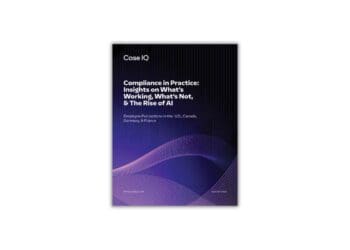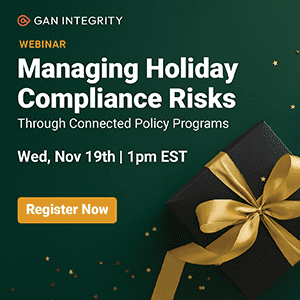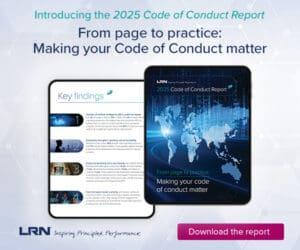Like a check engine light that warns of trouble before catastrophic failure, certain compliance metrics signal emerging risks before they escalate. InvestiNet compliance director Keshonda Walker explains how focusing on leading indicators — patterns in complaints, litigation trends, vendor incidents and audit score fluctuations — creates a more proactive approach than simply tracking violations.
Have you ever had your check engine light come on, only for the car to keep running just fine? No strange noises, no smoke — just a little amber light, glowing on the dashboard. It’s tempting to ignore it; after all, everything seems to be working as usual.
But anyone who’s owned a car long enough knows how that story can end. What starts as a seemingly harmless light can turn into a much bigger issue, like an expensive repair, a breakdown on the side of the highway or worse. The warning signs were there, we just didn’t investigate sooner.
In a way, compliance works the same. The most valuable insights often aren’t the ones that scream at you; they’re the quiet ones — the subtle uptick in complaints, the unexpected dip in an audit score, vendor incident that seems small on paper but hints at something deeper. These are our versions of the check engine light. They don’t always come with drama or noise, but they matter. And, if you’re paying attention, they can save you a lot of trouble down the road.
In compliance, we’re surrounded by data. Every interaction, every touchpoint and every incident is all measurable. But the real question is which numbers actually tell us something meaningful? Over the years, I’ve learned that the most valuable metrics are often the ones that signal what’s about to happen. Leading indicators serve as warning signs that help us spot risk before it becomes a fire drill.
At my company, these are examples of ones we pay close attention to:
Complaints. All of them.
Consumer complaints are an obvious one, but we also monitor issues raised by regulators, attorneys and even clients. When you see a pattern — a rise in credit bureau disputes or multiple people flagging the same issue — that’s not just noise; that’s a trend.
It’s worth noting that complaints are often the canary in the coal mine. While it might be tempting to dismiss an isolated complaint as a one-off, in reality, even a single complaint can reveal much larger operational or communication gaps. At InvestiNet, we treat every piece of feedback as data, not just for resolving an issue but for refining our overall approach. This creates a culture where a data-informed approach becomes a compliance advantage.
What Compliance Metrics Are Important for Reporting to Management?
From board to regulators, many stakeholders want insight into compliance metrics
Read moreDetailsLitigation and dispute trends
Litigation often gets lumped in with complaints, but it deserves its own lens. Tracking the types of lawsuits, or even just threats, can reveal systemic issues in how certain portfolios are handled. Dispute trends can also shine a light on underlying inefficiencies that may not be immediately visible elsewhere in operations.
For example, we noticed a spike in “paid prior” disputes for a particular client. It turned out their brick-and-mortar locations weren’t properly reporting in-store payments. What initially seemed like an isolated issue revealed a much larger pattern of miscommunication between the retail operations and back-end reporting. Without tracking that trend, we might have been too focused on or obstructed by the details to recognize the broader operational gap.
Litigation metrics often highlight the need for more cross-functional visibility. A single lawsuit may originate in one department’s workflow, but it can expose friction points across the entire system, from onboarding through to resolution. Monitoring litigation isn’t just about legal exposure; it’s also a powerful lens into operational health.
Vendor incidents
We work with a range of vendors, from data providers to collection partners. Any incident tied to a vendor — a missed service level agreement (SLA), a data security lapse or a contractual violation — gets flagged.
If a vendor experiences a phishing incident and waits a week to notify us (when the SLA may require 24 hours), that’s a red flag — not just for that vendor but for our overall vendor risk strategy. These incidents help us decide when it’s time to reevaluate partnerships or diversify providers.
Strong vendor oversight is more than checking a box. It requires establishing trust, defining accountability and maintaining transparency, even when things go wrong. Incident tracking becomes an essential signal: Are our partners as invested in our standards as we are? If not, that tells us more than any quarterly report ever could.
Audit score fluctuations
Audit results, both internal and external, are another key piece of the puzzle. While the audits themselves vary by vendor or function, tracking how scores change over time is what really matters. A sudden dip in one area could indicate something breaking down operationally before the issue escalates.
Audits should be viewed as opportunities, not obligations. Rather than fearing dips in scores, we treat them as insights into areas of friction or risk. This encourages continuous improvement rather than reactive scrambling. It’s not about being perfect; it’s about being aware and agile.
What makes these metrics powerful isn’t just tracking them; it’s how you analyze them. Too often, teams treat complaints or incidents as standalone events. But the real insight comes from connecting the dots, looking for patterns and identifying emerging risks.
We use our data to tell a story, not just fill a spreadsheet. We leverage technology to surface trends, connect data points and feed our dynamic risk matrix. This proactive approach helps us manage risk more effectively, support our clients more strategically and stay ahead of the curve in a fast-moving regulatory landscape.
A final thought
Compliance isn’t just about staying out of trouble; it’s about staying prepared. That preparation starts with awareness — not just of what has gone wrong but of what could go wrong next. The compliance landscape will never stop evolving, but with the right signals and a mindset that values proactivity over perfection, we believe it’s possible to lead with both integrity and insight.
Metrics only matter if you use them to drive better decisions. That’s our focus. And it’s what keeps us asking the right questions before the risk becomes reality.




 Keshonda Walker is compliance director at InvestiNet, a receivables management firm. She previously served in compliance roles at Provana and CARMA.
Keshonda Walker is compliance director at InvestiNet, a receivables management firm. She previously served in compliance roles at Provana and CARMA. 








